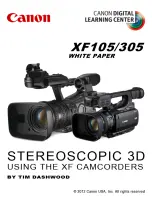
The trouble with using hyper-stereo is that scenes with gigantic objects in real-life may appear as
small models.
This phenomenon is known as
dwar
fi
sm
.
The opposite happens with hypo-stereo,
where normal sized objects appear gigantic. (
gigantism
.)
If one attempts to shoot with two cameras con
fi
gured in a side-by-side stereoscopic mount the
smallest interaxial distance available will be the width of the camera. In most cases the width of the
camera will be around 6 inches (as with the XF305.) This might seem like a big limiting factor, but
other specialized equipment is available to achieve small interaxial distances with almost any sized
camera. (More on that a in the “Selecting your Gear” segment.)
Viewing 3D: Passive Polarization, Active Shutter Glasses, Anaglyph & Autostereo
There are three basic types of glasses used for presenting stereoscopic 3D material.
In most of the
theatres in North America the common method is
passive polarized glasses
with either circular or
linear polarizers.
There are consumer and professional HD 3D monitors that use the same passive
method. However, the majority of the consumer 3DTVs on the market now use some form of
active
shutter glasses
to
fl
icker the left and right images on and o
ff
in time with the television at a frequency
of 60, 120 or 240Hz.
Autostereoscopic displays
use lenticular lenses or parallel barrier technologies to
present stereoscopic material without the use of glasses.
Anaglyph glasses
will work with almost any display but use color
fi
lters to separate the left and right
images.
The most common con
fi
gurations are red/cyan, blue/amber, and green/magenta.
THE QUICK MATH & SOME RULES TO REMEMBER
Stereoscopic Parallax Budget (sometimes called Depth Budget) vs Depth Bracket
The Depth Bracket of your scene refers to the actual distance between your closest object in the
frame and the furthest object. The Parallax Budget refers to your calculated maximum positive
parallax and desired maximum negative parallax represented in percentage of screen width. For
example if I determine through a simple calculation that my positive parallax should never exceed
0.7% of screen width and I have determined that my negative parallax should not exceed 2% of
screen width, then my total Parallax Budget is 2.7%. The Depth Bracket must be able to be squeezed
into the Parallax Budget. There are many advanced algebraic formulas available to determine the
proper interaxial distance to achieve this, but are beyond the scope of this white paper.
Native Parallax for
fi
nal display size
The native parallax for a given screen size simply refers to what percentage of screen width will equal
the human interocular. If you are using 2.5 inches as the baseline interocular and you know your
presentation screen will be 30 feet wide (360 inches) then just divide 2.5 by 360.
2.5
÷ 360 = 0.007
XF300/305 Whitepaper
Stereoscopic 3D
Tim Dashwood
6
Содержание XF105
Страница 1: ......



































